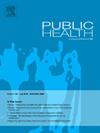Impact of COVID-19 on maternal health and birth outcomes: A network analysis in Alabama
IF 3.9
3区 医学
Q1 PUBLIC, ENVIRONMENTAL & OCCUPATIONAL HEALTH
引用次数: 0
Abstract
Objectives
This study aimed to assess the effects of COVID-19 on birth outcomes for women in Alabama by comparing data from pre-pandemic years (2018 and 2019) to post-pandemic years (2021 and 2022).
Study design
Retrospective cohort study with network analysis.
Methods
The study used a retrospective cohort design to compare maternal and birth outcomes before and after the COVID-19 pandemic, with network analysis employed to evaluate changes in the complexity of multimorbidity interactions during these two periods.
Maternal health metrics, including maternal age, number of prenatal visits, weight at delivery, number of morbidities, BMI, gestational diabetes, hypertension, premature births, and NICU admissions, were analyzed to assess changes between pre-pandemic (2018–2019) and post-pandemic (2021–2022) periods. Ethnicity disparities, particularly among American Indian or Alaska Native and Black mothers, were evaluated in relation to BMI, comorbidities, and previous cesarean rates.
Results
The analysis revealed significant changes in maternal health metrics during the pandemic. Post-pandemic, average maternal age increased from 27.45 to 27.80 years (p < 0.001), prenatal visits decreased from 10.44 to 10.27 (p < 0.001), and BMI rose from 27.72 to 28.24 kg/m2 (p < 0.001). Gestational diabetes increased from 5.53 % to 6.54 %, hypertension from 10.45 % to 12.72 %, premature births from 4.65 % to 6.52 %, and NICU admissions from 8.93 % to 10.24 % (all p < 0.001). Network analysis demonstrated that the complexity of the multimorbidity network worsened after COVID-19, indicating more intricate and interconnected disease interactions. Ethnicitydisparities were also evident, with American Indian or Alaska Native and Black mothers disproportionately affected, showing substantial increases in BMI, age, weight, and previous cesarean rates.
Conclusions
These findings underscore the exacerbation of health disparities during the pandemic, highlighting the need for targeted interventions and continued research on COVID-19's long-term effects.
COVID-19对孕产妇健康和分娩结果的影响:阿拉巴马州的网络分析
本研究旨在通过比较大流行前(2018年和2019年)和大流行后(2021年和2022年)的数据,评估COVID-19对阿拉巴马州女性分娩结果的影响。研究设计采用网络分析的回顾性队列研究。方法采用回顾性队列设计,比较COVID-19大流行前后的孕产妇和分娩结局,并采用网络分析来评估这两个时期多疾病相互作用复杂性的变化。分析了孕产妇健康指标,包括孕产妇年龄、产前就诊次数、分娩体重、发病率、BMI、妊娠糖尿病、高血压、早产和新生儿重症监护病房入院,以评估大流行前(2018-2019)和大流行后(2021-2022)期间的变化。种族差异,特别是在美国印第安人或阿拉斯加原住民和黑人母亲之间,评估了与BMI、合并症和既往剖宫产率的关系。结果分析显示,大流行期间孕产妇保健指标发生了重大变化。大流行后,产妇的平均年龄从27.45岁增加到27.80岁(p <;0.001),产前就诊从10.44次降至10.27次(p <;0.001), BMI由27.72上升至28.24 kg/m2 (p <;0.001)。妊娠期糖尿病从5.53%增加到6.54%,高血压从10.45%增加到12.72%,早产从4.65%增加到6.52%,新生儿重症监护病房入院率从8.93%增加到10.24% (p <;0.001)。网络分析表明,新冠肺炎疫情后,多病网络的复杂性加剧,表明疾病相互作用更加复杂和相互关联。种族差异也很明显,美国印第安人或阿拉斯加原住民和黑人母亲受到的影响不成比例,显示出体重指数、年龄、体重和先前剖宫产率的大幅增加。这些发现凸显了疫情期间健康差距的加剧,凸显了采取有针对性的干预措施和继续研究COVID-19长期影响的必要性。
本文章由计算机程序翻译,如有差异,请以英文原文为准。
求助全文
约1分钟内获得全文
求助全文
来源期刊

Public Health
医学-公共卫生、环境卫生与职业卫生
CiteScore
7.60
自引率
0.00%
发文量
280
审稿时长
37 days
期刊介绍:
Public Health is an international, multidisciplinary peer-reviewed journal. It publishes original papers, reviews and short reports on all aspects of the science, philosophy, and practice of public health.
 求助内容:
求助内容: 应助结果提醒方式:
应助结果提醒方式:


